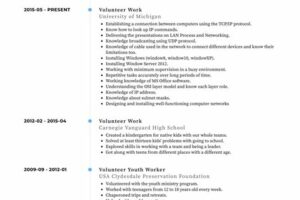Table of Contents
Discover different corporate volunteer program models and their benefits. Explore how businesses can engage employees in volunteering activities to make a positive impact on the community. From skills-based volunteering to team-building initiatives, find the right model to enhance corporate social responsibility efforts and foster employee engagement.
Corporate Volunteer Program Models have become increasingly popular in recent years, as companies recognize the benefits of engaging their employees in meaningful community service. With the rise of corporate social responsibility and the growing emphasis on giving back, organizations are seeking innovative ways to involve their workforce in volunteer activities. From team-building exercises to skills-based volunteering, these models offer a range of opportunities for employees to make a positive impact while also enhancing their professional development. Moreover, by aligning their philanthropic efforts with their business objectives, companies can foster a sense of purpose among their employees and strengthen their reputation as socially responsible entities.
Introduction
In recent years, corporate volunteer programs have gained significant popularity as a means for organizations to give back to their communities. These programs not only benefit the communities they serve but also contribute to the professional and personal development of employees. However, designing an effective corporate volunteer program requires careful consideration of various models that align with the organization’s goals and resources.
Employee-Driven Volunteerism
What is Employee-Driven Volunteerism?
Employee-driven volunteerism is a model where employees take the lead in selecting and organizing volunteer activities. This model empowers employees to engage in causes they are passionate about and allows for a diverse range of community engagement opportunities.
Benefits
This model fosters employee engagement, boosts morale, and enhances teamwork within the organization. It provides employees with a sense of ownership and gives them the opportunity to develop leadership and organizational skills.
Considerations
While employee-driven volunteerism promotes autonomy and diversity in volunteering efforts, it requires proper coordination and support from the organization to ensure alignment with its values and objectives.
Skills-Based Volunteering
What is Skills-Based Volunteering?
Skills-based volunteering focuses on utilizing employees’ professional skills and expertise to address community needs effectively. This model matches employees’ talents with specific projects or organizations that can benefit from their knowledge.
Benefits
Skills-based volunteering provides a unique opportunity for employees to apply their expertise in a meaningful way. It enhances employee job satisfaction, promotes skill development, and creates lasting impact through targeted assistance to nonprofit organizations.
Considerations
Implementing skills-based volunteering requires identifying suitable projects and organizations that require specific skill sets. It may also necessitate additional training or coordination to ensure employees are adequately prepared for their volunteer roles.
Team-Building Volunteer Programs
What are Team-Building Volunteer Programs?
Team-building volunteer programs focus on engaging employees in group activities that promote collaboration and strengthen relationships within the organization. These programs often involve hands-on volunteering experiences that require teamwork and cooperation.
Benefits
Team-building volunteer programs foster a sense of camaraderie, improve communication, and enhance trust among team members. They can also improve employee motivation and productivity by creating a positive work environment.
Considerations
Designing team-building volunteer programs requires careful planning to ensure activities are inclusive, accessible, and enjoyable for all employees. It is essential to select volunteer opportunities that align with the organization’s goals while providing meaningful team-building experiences.
Disaster Relief Initiatives
What are Disaster Relief Initiatives?
Disaster relief initiatives involve mobilizing employees to provide support and assistance in response to natural disasters or humanitarian crises. These initiatives focus on helping affected communities rebuild and recover.
Benefits
Participating in disaster relief initiatives allows employees to make a direct and immediate impact in times of crisis. It strengthens the organization’s reputation and demonstrates its commitment to social responsibility.
Considerations
Organizations need to establish partnerships with reputable aid organizations to ensure the safety and effectiveness of their disaster relief efforts. Adequate training and support must be provided to employees engaged in such initiatives.
Virtual Volunteering
What is Virtual Volunteering?
Virtual volunteering allows employees to contribute their time and skills remotely, utilizing technology to engage in volunteer activities. This model enables employees to volunteer flexibly, regardless of their location or work schedule.
Benefits
Virtual volunteering offers flexibility and convenience for employees, making it accessible to a broader range of participants. It also reduces costs associated with traditional volunteer programs, such as travel expenses.
Considerations
Organizations must ensure that virtual volunteering opportunities align with their mission and values. They need to establish effective communication channels and provide necessary resources to support remote volunteer engagement.
Conclusion
Corporate volunteer programs provide numerous benefits to both organizations and employees, fostering community involvement and personal growth. By selecting an appropriate program model, organizations can create impactful volunteering experiences that align with their resources, values, and goals. Whether through employee-driven initiatives, skills-based volunteering, team-building programs, disaster relief efforts, or virtual engagement, corporate volunteerism has the power to make a positive difference in society.
Corporate Volunteer Program Models
Corporate volunteer programs have become a valuable tool for companies to engage in community service and promote social responsibility. These programs offer various models that cater to the unique skills and interests of employees, allowing them to make a meaningful impact in the community. In this article, we will explore eight different corporate volunteer program models, highlighting their benefits and how they contribute to both employee development and community welfare.
I. Company-Supported Volunteer Programs
Company-supported volunteer programs are designed to encourage employees to participate in community service during work hours. Companies often provide paid time off or flexible schedules to ensure employees can engage in volunteering activities. By fostering a culture of giving back, these programs promote social responsibility and create a sense of pride among employees.
II. Skills-Based Volunteer Programs
In the skills-based volunteer program model, companies leverage the specific expertise and skills of their employees to support nonprofit organizations. Employees are encouraged to volunteer their professional skills, such as marketing, finance, or IT, to address the unique challenges faced by these organizations. This model not only allows employees to make a meaningful impact but also enhances their professional development and engagement.
III. Team-Based Volunteer Programs
Team-based volunteering involves groups of employees coming together to complete specific projects or tasks for nonprofit organizations. This model promotes collaboration, strengthens team dynamics, and boosts employee morale. By working together towards a common goal, employees not only contribute to the needs of the community but also develop stronger bonds with their colleagues.
IV. Pro Bono Programs
Pro bono programs enable employees to provide professional services to nonprofit organizations on a voluntary basis. This model allows employees to share their expertise, knowledge, and experience to address complex challenges faced by nonprofits. By offering their skills free of charge, employees become a valuable resource for organizations with limited resources, creating a lasting impact on the community.
V. Virtual Volunteer Programs
In the digital age, virtual volunteering programs have gained popularity. Companies organize opportunities for employees to engage in volunteer work remotely, utilizing their skills from any location. This model allows for flexibility and accessibility, enabling employees to make a difference without physical presence. Virtual volunteering also opens doors for employees to contribute to global causes and organizations.
VI. Board Service Programs
Board service programs encourage employees to serve on the boards of nonprofit organizations. By joining a nonprofit board, employees can contribute to the organization’s decision-making process and long-term strategic planning. This model effectively utilizes employees’ leadership skills while supporting the nonprofit’s mission. Board service programs not only benefit the community but also provide employees with valuable networking opportunities and insights into nonprofit governance.
VII. Skills-Based Volunteering Sabbaticals
Some companies offer their employees the opportunity to take a paid sabbatical to engage full-time in skills-based volunteering for a certain duration. This model allows employees to immerse themselves in a volunteering project, make a significant impact, and develop new skills that can benefit both the community and the company upon their return. Skills-based volunteering sabbaticals provide employees with a unique opportunity for personal growth and fulfillment.
VIII. Philanthropic Matching Programs
Corporate philanthropic matching programs motivate employees to participate in volunteer activities by matching their donations or volunteer hours with monetary contributions from the company. This model not only encourages employees to engage in community service but also amplifies the impact of their contributions through financial support from their employer. Philanthropic matching programs create a sense of shared responsibility between the company and its employees, further strengthening their commitment to giving back.
In conclusion, corporate volunteer program models play a crucial role in fostering a culture of giving back and social responsibility within companies. These programs not only benefit the community but also contribute to employee development and engagement. Whether through company-supported initiatives, skills-based volunteering, team-based projects, pro bono work, virtual opportunities, board service, sabbaticals, or philanthropic matching programs, companies can make a significant impact on society while empowering their employees to create positive change.
Corporate volunteer programs have become increasingly popular in recent years as companies recognize the benefits of giving back to their communities. These programs provide employees with opportunities to engage in meaningful volunteer work while also enhancing their professional development and promoting a positive company culture. There are several different models that companies can adopt when implementing a corporate volunteer program, each with its own unique advantages and considerations.
1. Skills-Based Volunteering:
- This model focuses on leveraging employees’ professional skills and expertise to address specific community needs.
- Employees are matched with nonprofit organizations or projects that align with their areas of expertise, allowing them to make a significant impact through their specialized knowledge.
- Skills-based volunteering provides employees with the opportunity to enhance their professional skills, gain real-world experience, and develop leadership capabilities.
- It also allows companies to showcase their expertise and contribute to solving societal challenges in a strategic and targeted manner.
2. Team-Based Volunteering:
- This model emphasizes teamwork and collaboration among employees, fostering a sense of unity and camaraderie within the company.
- Employees are organized into teams and assigned group volunteer projects, such as building homes, cleaning up parks, or organizing fundraising events.
- Team-based volunteering promotes employee engagement, enhances communication and problem-solving skills, and strengthens relationships among colleagues.
- It also provides an opportunity for employees to connect with their local communities and gain a broader perspective on social issues.
3. Pro Bono Volunteering:
- This model involves offering professional services to nonprofit organizations on a pro bono basis.
- Employees use their specialized skills to provide valuable services such as legal advice, marketing strategies, or financial consulting.
- Pro bono volunteering allows companies to support nonprofit organizations in a way that aligns with their core competencies.
- It provides employees with the opportunity to apply their expertise in a different context, gain a sense of fulfillment, and expand their professional networks.
4. Employee-Driven Volunteering:
- This model empowers employees to take the lead in identifying and organizing volunteer initiatives.
- Companies provide resources and support to facilitate employee-driven volunteer projects, which can range from local community service activities to international volunteering trips.
- Employee-driven volunteering promotes employee empowerment, leadership development, and a sense of ownership in making a positive impact.
- It allows employees to pursue causes they are passionate about and encourages creativity and innovation in addressing social issues.
In conclusion, corporate volunteer programs offer numerous benefits for both companies and employees. When choosing a program model, it is important to consider the unique needs and objectives of the company, as well as the skills and interests of the employees. By implementing a well-designed corporate volunteer program, companies can contribute to their communities, enhance employee engagement and satisfaction, and reinforce their commitment to social responsibility.
Thank you for taking the time to explore our blog and learn about the various corporate volunteer program models available today. We hope that this article has provided you with valuable insights and information on how organizations can effectively engage their employees in giving back to the community.
Corporate volunteer programs have become increasingly popular in recent years, as companies recognize the importance of social responsibility and the positive impact it can have on both their employees and the communities they serve. These programs not only allow employees to contribute their time and skills to meaningful causes, but also provide numerous benefits to the company itself.
There are several different models of corporate volunteer programs, each with its own unique features and advantages. From skills-based volunteering, where employees offer their professional expertise to non-profit organizations, to team-building activities that promote collaboration and camaraderie among colleagues, these programs can be tailored to suit the specific needs and goals of any organization.
Furthermore, corporate volunteer programs offer numerous benefits to companies. They can enhance employee engagement and job satisfaction, as individuals feel a sense of pride and fulfillment in making a difference in their community. These programs also provide opportunities for professional development, as employees can develop new skills and gain valuable experiences through their volunteer work.
In conclusion, corporate volunteer programs are a win-win for both companies and their employees. By implementing these programs, organizations can foster a positive workplace culture, enhance their reputation, and make a meaningful impact on society. We encourage you to explore the various models discussed in this article and consider how they can be adapted to your own organization’s needs. Together, we can create a better world through corporate social responsibility.
Thank you once again for visiting our blog, and we hope to see you again soon!
Video Corporate Volunteer Program Models
1. What are the different models of corporate volunteer programs?
There are several different models of corporate volunteer programs that organizations can adopt:
- Skills-based volunteering: This model focuses on leveraging employees’ professional skills and expertise to benefit nonprofits and communities.
- Team volunteering: In this model, employees come together as teams to engage in volunteer activities, fostering teamwork and camaraderie.
- Virtual volunteering: This model allows employees to contribute their time and skills remotely, through online platforms or digital initiatives.
- Pro bono volunteering: Companies provide employees with opportunities to offer their professional services to nonprofits or socially impactful projects.
- Corporate-sponsored volunteer events: This model involves organizing large-scale volunteer events or campaigns, often in collaboration with nonprofit partners.
2. How can companies select the most suitable corporate volunteer program model?
In selecting the most suitable corporate volunteer program model, companies should consider various factors:
- Employee preferences and interests: Companies should assess the interests and skills of their employees to identify which models align best with their workforce.
- Organizational goals: It is important to align the chosen model with the company’s overall corporate social responsibility objectives and values.
- Available resources: Companies should evaluate their available resources, such as time, budget, and infrastructure, to determine which models are feasible to implement.
- Community needs: Understanding the specific needs of the communities where the company operates can help in selecting a model that addresses those needs effectively.
3. How can corporate volunteer programs be integrated with employee development?
Integrating corporate volunteer programs with employee development can be achieved through:
- Skills enhancement: Companies can offer volunteering opportunities that allow employees to develop new skills or enhance existing ones.
- Leadership opportunities: Volunteering can provide employees with leadership roles, enabling them to practice and improve their leadership skills.
- Mentorship and coaching: Pairing employees with nonprofit partners or community members for mentorship or coaching can foster personal and professional growth.
- Recognition and rewards: Recognizing and rewarding employees’ volunteer efforts can motivate them to continue participating in the program and contribute to their personal development.
4. How can corporate volunteer programs measure their impact?
Measuring the impact of corporate volunteer programs can be done through various methods:
- Quantitative metrics: Companies can measure the number of volunteer hours contributed, the number of beneficiaries reached, or the monetary value of the services provided.
- Qualitative feedback: Gathering feedback from volunteers, nonprofit partners, and community members can help assess the qualitative impact of the program.
- Social and environmental indicators: Tracking the social and environmental outcomes resulting from the volunteer activities can provide insights into the program’s impact.
- Long-term tracking: Monitoring the long-term effects of the program on employee engagement, retention, and overall corporate reputation can demonstrate the program’s success.






